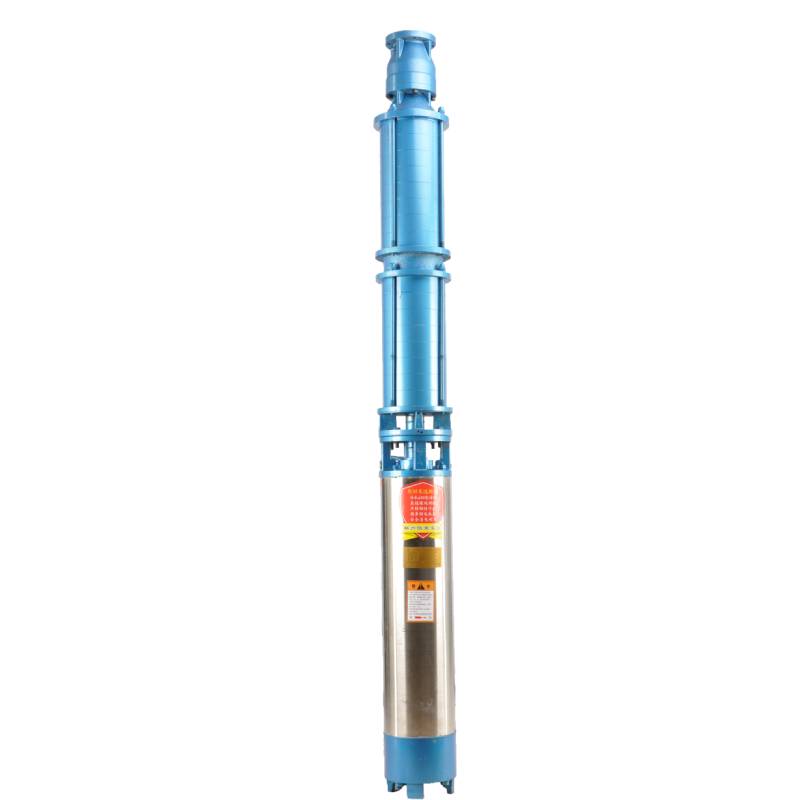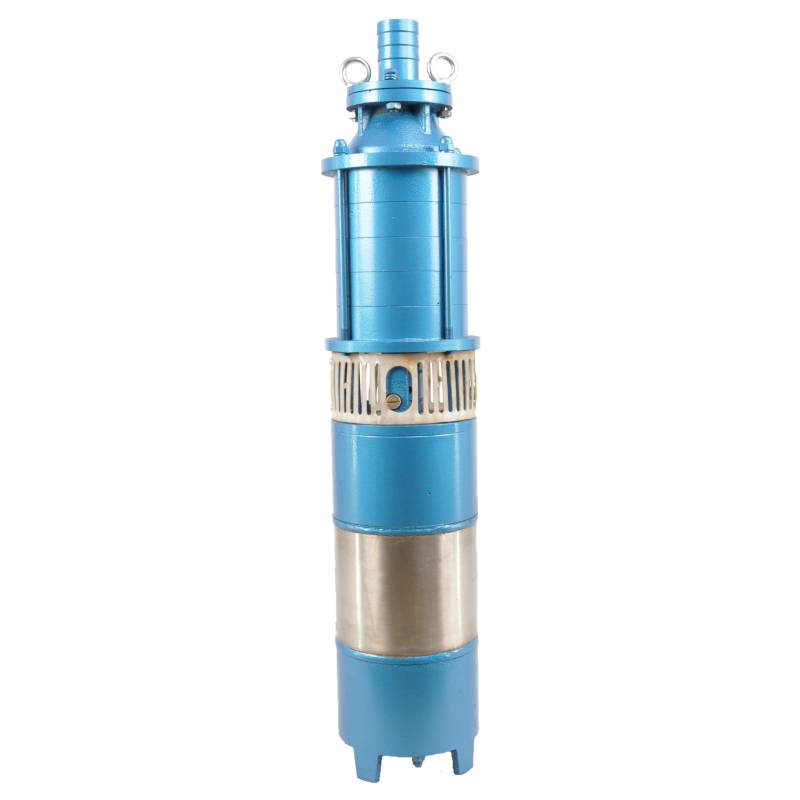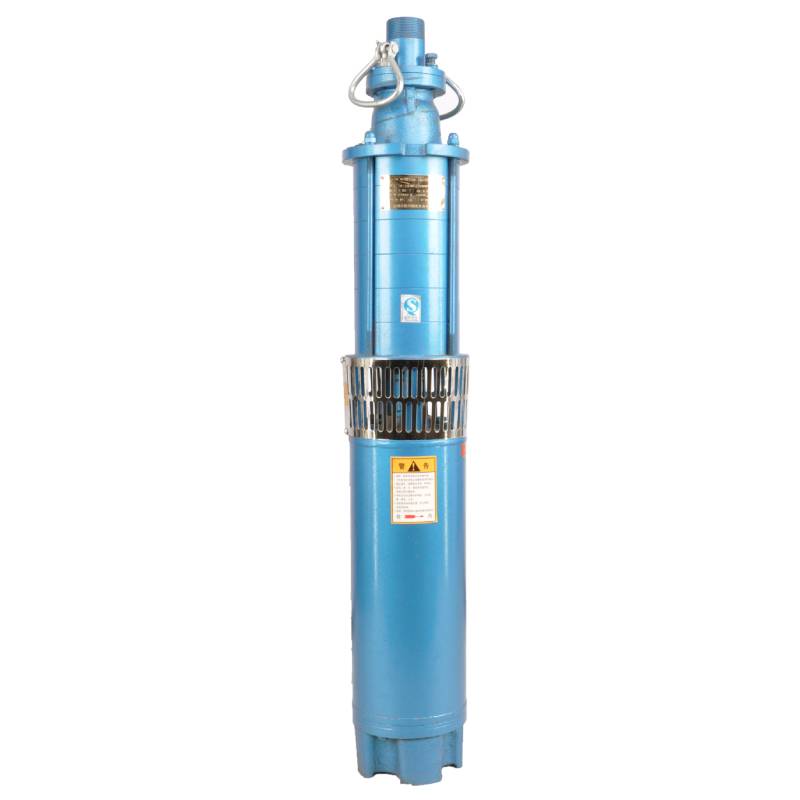QS letoto la submersible sisteme ea motlakase ke mofuta o mocha oa mochini o nosetsang le oa drainage. Letoto lena la lipompo li theohile, li sebelisa radial positive and negative guide vane design, molumo o monyenyane, boima bo bobebe, ho phahamisa holimo, ho kenya habonolo le ho sisinyeha, tlhokomelo e bonolo le ts'ebetso.
Phallo e fapaneng 5-50m3 / h, phahamisa 5-800m.
The product is equipped with three-phase AC 380V (tolerance is ± 5%), 50 Hz (tolerance is ± 1%) power supply. Water quality requirements are:
(1) water temperature shall not be higher than 20 °C;
(2) litaba tsa litšila tse tiileng (karolelano ea bongata) ha e na ho feta 0.01%;
(3) PH boleng (pH) ke 6.5-8.5;
(4) hydrogen sulfide content ha ea lokela ho ba kholo ho feta 1.5 mg / L;
(5) chloride ion content e ke ke ea e-ba kholo ho feta 400 mg / L. Enjene ke mohaho o koetsoeng kapa o tletseng metsi a metsi.
Pele o sebelisoa, sekoti se ka hare sa koloi e ka tlas'a metsi se tlameha ho tlatsoa ka metsi a hloekileng, 'me ente ea metsi le liboutu tsa ho ntša moea li tla tiisetsoa, ho seng joalo li ke ke tsa sebelisoa. Pompo e ka tlas'a metsi e tlameha ho qoelisoa ka ho feletseng ka metsing ho sebetsa, botebo ba ho kenngoa ha boa lokela ho feta limithara tse 70, 'me sebaka se pakeng tsa tlase ea pompo e ka tlas'a metsi le botebo ba seliba ha sea lokela ho ba tlase ho 3 metres. Phallo ea metsi a seliba e tla finyella litlhoko tsa ho kenngoa ha metsi le litlhoko tse tsoelang pele tsa ts'ebetso ea pompo e ka tlas'a metsi, 'me tlhahiso ea metsi ea pompo e ka tlas'a metsi e tla laoloa ka makhetlo a 0.7-1.2 ho phalla ho lekanngoa. Seliba se tlameha ho ba se otlolohileng, 'me pompo e ka tlas'a metsi e ke ke ea sebelisoa ka mokhoa o otlolohileng kapa o sekame, empa e otlolohile feela. Pompo e ka tlas'a metsi e tlameha ho kopanngoa le likhoele 'me e be le lisebelisoa tsa ts'ireletso tse tsoang kantle ho naha kamoo ho hlokahalang. Pompo e ka tlas'a metsi e thibetsoe ka thata ho etsa tlhahlobo ntle le ho roala metsi.
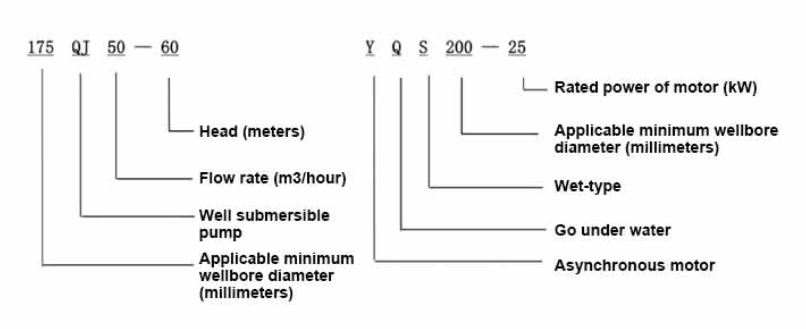
| Tafole ea ts'ebetso ea pompo ea 200 QS e ka tlase ho metsi Letoto le ikhethileng le sa tloaelehang |
||||||||
| mohlala | mohlala | |||||||
| QS5-70-2.2KW | QS10-52-4KW | |||||||
| QS5-90-3KW | QS10-70-5.5KW | |||||||
| QS5-108-4KW | QS10-90-7.5KW | |||||||
| QS5-126-5.5KW | QS10-108-7.5KW | |||||||
| QS5-144-5.5KW | QS20-40-4KW | |||||||
| QS5-160-7.5KW | QS20-54-5.5KW | |||||||
| QS5-180-7.5KW | QS20-65-7.5KW | |||||||
| QS10-36-2.2KW | QS20-81-7.5KW | |||||||
| QS10-54-3KW | QS32-13-2.2KW | |||||||
| QS10-70-4KW | QS32-26-4KW | |||||||
| QS10-90-5.5KW | QS32-52-7.5KW | |||||||
| QS10-108-5.5KW | QS40-39-7.5KW | |||||||
| QS10-126-7.5KW | QS40-13-4KW | |||||||
| QS10-140-7.5KW | QS40-26-5.5KW | |||||||
| QS15-38-3KW | QS50-13-4KW | |||||||
| QS15-54-4KW | QS50-26-5.5KW | |||||||
| QS15-65-5.5KW | QS50-39-7.5KW | |||||||
| QS15-81-5.5KW | QS63-12-4KW | |||||||
| QS15-100-7.5KW | QS63-24-7.5KW | |||||||
| QS20-30-3KW | QS80-11-4KW | |||||||
| QS20-45-4KW | QS80-22-7.5KW | |||||||
| QS20-60-5.5KW | QS10-88-7.5KW | |||||||
| QS20-75-7.5KW | QS10-105-7.5KW | |||||||
| QS20-81-7.5KW | QS40-52-11KW | |||||||
| QS10-198-15KW | QS50-60-11KW | |||||||
| QS10-160-9.2KW | QS65-30-9.2KW | |||||||
| QS15-180-15KW | QS80-28-9.2KW | |||||||
| QS10-180-11KW | QS125-15-7.5KW | |||||||
1, pompo e kentsoeng hantle ea metsi bakeng sa pompo ea metsi a hloekileng, e thibela ho hlatsoa seliba se secha, ho pompa seretse le metsi a seretse,
2, sehlopha sa 380/50HZ sa pompo ea metsi, ts'ebeliso ea li-voltage tse ling tsa li-motors tse ka tlas'a metsi li hloka ho hlophisoa. Lithapo tsa Downhole li tlameha ho sebelisa lisebelisoa tse sa keneleng metsi, li tlameha ho ba le lisebelisoa tsa ho qala, joalo ka lebokose la kabo, ha li qala li sa itokisetsa li lokela ho ba le ts'ebetso e tloaelehileng ea ts'ireletso e felletseng, joalo ka ts'ireletso e khuts'oane ea potoloho, ts'ireletso ea mohato, ts'ireletso ea undervoltage, ts'ireletso ea fatše, ts'ireletso ea idling, maemong a sa tloaelehang, sesebelisoa sa ts'ireletso e lokela ho ba leetong la ts'ebetso ka nako.
3, pompo e tlameha ho theoa ka mokhoa o tšepahalang ts'ebetsong ea ho kenya le ho e sebelisa. E thibetsoe matsohong le maotong metsi push-pull switjha. Pele o kenya le ho boloka pompo, matla a tlameha ho khaoloa. E behiloe sebakeng seo pompo e sebelisoang ho sona, e tlameha ho tšoauoa ka ho hlaka "thibela ho tsosoa ha motlakase". Pele o theohela selibeng kapa ho kenya, sekoti sa motlakase se tlameha ho tlatsoa ka metsi a hloekisitsoeng kapa metsi a batang a sa cheng, ebe o tiisa bolt ea metsi / drain.
4, ha ts'ebetso ea lipuisano ea sebaka sa pompo, metsi a tlameha ho tšeloa ka kamoreng ea pompo ho tlotsa bere ea rabara. Nako ea ho qala hang-hang e ke ke ea feta motsotsoana o le mong, hlahloba hore na tataiso e tšoana le taelo ea ho tsamaisa. Ha pompo e otlolohile, ela hloko polokeho, thibela ho phethoha le ho tsoa kotsi.
5, ka tieo ho ea ka lipehelo tsa phahamiso ea pompo, mefuta e mengata ea ts'ebeliso ea phallo, ho thibela phallo e tlase kapa matla a ho pompa a phahamiso e phahameng, ho ts'oara le likarolo tse ling tsa ho roala, moroalo oa motlakase o chesitsoe 6, kamora hore pompo e theohe selibeng, tekanyo ea enjene ho ea fatše insulation ho hanyetsa ha ea lokela ho ba ka tlaase ho 100M, ka mor'a ho qala ho boloka gagamalo le hona joale, hlahloba motor matsoelintsoeke insulation, ebang ke tumellanong le ditlhoko; pompo polokelo sebaka mocheso haeba ka tlaase ho ntlha leqhoa, e lokela ho omella ka koloi cavity metsi, ho thibela koloi cavity metsi tšenyo ea leqhoa bakoang ke mocheso tlaase.
The pump part is mainly composed of pump shaft, impeller, guide housing, rubber bearing, check valve body (optional) and other components. The motor part mainly includes base, pressure regulating diaphragm, thrust bearing, thrust plate, lower guide bearing seat, stator, rotor, upper guide bearing seat, sand discharging ring, water inlet section, lead cable and other components. The main characteristics of this product are that the motor is a water-immersed three-phase asynchronous motor, and the motor cavity is filled with water to cool the motor and lubricate the bearing. The pressure regulating film at the bottom is used to adjust the pressure difference of the water body in the cavity caused by the temperature rise of the motor. In order to prevent the sand from entering the motor, the upper end of the motor shaft extension is equipped with two oil seals and installed a sand discharging ring, forming a sand prevention structure. At the same time, in order to prevent the pump shaft from jumping when starting, the pump shaft is connected with the motor shaft by a coupling, and the thrust bearing is installed under the motor. The lubrication of the whole product is water lubrication, and the motor stator winding is made of high quality submersible motor winding wire with high insulation performance. In addition, the pump is designed by computer CAD, with simple structure and excellent technical performance.

(1) Tokisetso pele ho ho kenya:
1. Lekola hore na pompo e ka tlas'a metsi e kopana le maemo a ts'ebeliso le boholo bo boletsoeng bukeng ea tataiso.
2. Ho sebelisa obiect e boima e nang le bophara bo lekanang le bophara bo boholo ba ka ntle ba pompo e ka tlas'a metsi, lekanya hore na inneldiameter ea seliba e ka lumellana le pompo e ka tlas'a metsi, 'me u lekanye hore na botebo ba seliba bo finyella litlhoko tsa ho kenya.
3. Lekola hore na seliba se hloekile le hore na metsi a seliba a litšila. Le ka mohla u se ke ua sebelisa pompo ea motlakase e ka tlas'a metsi ho hlatsoa seretse sa pompo ea welor le metsi a lehlabathe ho qoba tšenyo ea pele ho nako ea pompo ea motlakase e ka tlase ho metsi.
4. Sheba hore na boemo ba letlapa la ho kenya welhead le loketse le hore na le khona ho mamella boleng ba yuniti kaofela.
5. Sheba hore na likarolo tsa pompo tse ka tlas'a metsi li phethehile 'me li kentsoe ka nepo ho ea ka setšoantšo sa kopano se bukeng ea litaelo Tlosa skrine ea sefe 'me u potolohe sekopanyi ho bona hore na se potoloha ka mokhoa o bonolo.
6. Hlakola sekoti sa metsi 'me u tlatse lesoba la motlakase ka metsi a hloekileng, a sa cheng (hlokomela. etsa bonnete ba hore u se tlatse), ebe u tiisa sekheo sa metsi. Kamora lihora tse 12 tsa ente ea metsi, khanyetso ea enjene ha ea lokela ho ba ka tlase ho 150M Q ha e lekantsoe ka tafole ea 500V e sisinyehang.
7. Cable joint, cut off a 120mm rubber sleeve from one end of the outgoing cable and the matching cable with an electrician's knifethen stagger the length of the three core wires in a stepped shape, peel off a 20mm copper core, scrape of the oxide layer on theoutside of the copper wire with a knife or sand cloth, and insert the two connected wire ends in palirs.After tying the layer tightly with fine copper wire, solder it thoroughly and firmly, and sand of any. burrs on the surface. Then, forthe three joints, use polyvester insulation tape to wrap them in a semi stacked manner for three lavers. Wrap the two ends of thewrapping layer tightywith nyion thread,and then use a semi stacked method to wrap the tape for three layers. Wrap the outellayer with high-pressure insulation tape for three layers. Finally, fold the threestrands together and repeatedly wrap them for fivelayers with high-pressure tape. Each layer must be tightly tied, and the interlayer joints must be tight and fimm to prevent water frompenetrating and damaging the insulation, After wrapping, soak in water at room temperature of 20 ’c for 12 hours, and measurethe insulation resistance with a shaking table, which should not be less than 100M Ω
Sets'oants'o sa ts'ebetso ea terata ea cable e kenyellelitsoeng ka tsela e latelang: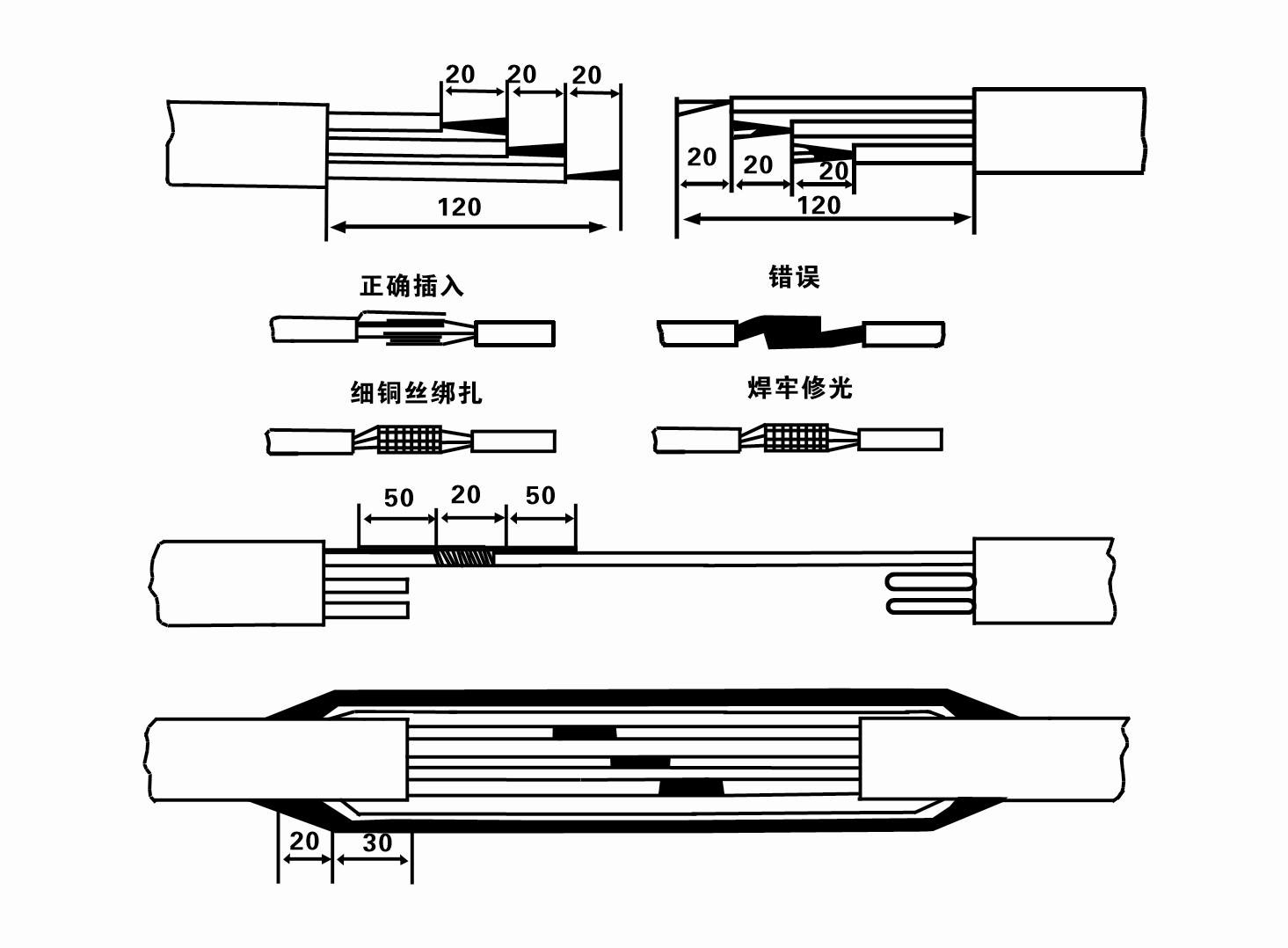
8. Sebelisa multimeter ho hlahloba hore na lithapo tsa mekhahlelo e meraro li hokahane le hore na ho hanyetsa ha DC ho batla ho leka-lekana.
9. Lekola hore na matla a potoloho le a transformer a tletse, ebe o hokahanya sesebelisoa sa ts'ireletso ea overload kapa lisebelisoa tsa ho qala. Sheba Tafole ea 2 bakeng sa mefuta e ikhethileng, ebe u tšela bakete ea metsi ka har'a pompo ea metsi ho tsoa sebakeng sa pompo ea metsi ho tlotsa li-bearings tsa rabara ka har'a pompo, ebe u beha pompo ea motlakase e ka tlas'a metsi e otlolohile ebile e tsitsitse. Qala (e seng ho feta motsotsoana) 'me u hlahlobe hore na tataiso ea tsamaiso e lumellana le letšoao la ho tsamaisa. Haeba ho se joalo, fapanyetsana lihokelo leha e le life tse peli tsa mohala oa mekhahlelo e meraro. Ebe u kenya filthara 'me u itokisetse ho theohela selibeng. Haeba e sebelisoa liketsahalong tse khethehileng (tse kang liforo, liforo, linōka, matangoana, matangoana, joalo-joalo), pompo ea motlakase e tlameha ho thehoa ka mokhoa o tšepahalang.
(2) Lisebelisoa le lisebelisoa tsa ho kenya:
1. Para e le 'ngoe ea liketane tse phahamisang lithane tse fetang tse peli.
2. Tripod e nang le bophahamo bo otlolohileng bo sa feteng limithara tse 'nè.
3. Liropo tse peli tse leketlileng (lithapo tsa terata) tse ka jarang boima ba lithane tse fetang e le 'ngoe (li ka jara boima ba sete e felletseng ea lipompo tsa metsi).
4. Kenya lipara tse peli tsa li-clamp (li-splints).
5. Li-wrenches, lihamore, screwdrivers, lisebelisoa tsa motlakase le lisebelisoa, joalo-joalo.
(3) Ho kenya pompo ea motlakase:
1. Setšoantšo sa ho kenya pompo ea motlakase e ka tlas'a metsi e bontšoa ho Setšoantšo sa 2. Litekanyo tse khethehileng tsa ho kenya li bontšoa ho Lethathamo la 3 "Lethathamo la Litekanyo tsa ho Kenyeletsoa ha Pompo ea Motlakase ea Submersible".
2. Lipompo tsa motlakase tse ka tlas’a metsi tse nang le hlooho e ka tlaase ho limithara tse 30 li ka phahamisoa ka ho toba selibeng ho sebelisa liphaepe le lithapo tsa terata kapa lithapo tse ling tsa hemp tse ka khonang ho jara boima bo feletseng ba mochine kaofela, lipeipi tsa metsi, le metsi a liphaephe.
3. Lipompo tse nang le hlooho ea limithara tse fetang 30 li sebelisa liphaephe tsa tšepe, 'me tatellano ea ho kenya e tjena:
① Sebelisa clamp ho tiisa ntlha e ka holimo ea karolo ea pompo ea metsi (enjene le pompo ea metsi li se li hokahantsoe ka nako ena), e phahamise ka ketane e leketlileng, 'me butle-butle e e tlamelle ka selibeng ho fihlela u Beha thipa holim'a seliba ebe u tlosa ketane e leketlileng.
② Sebelisa para e 'ngoe ea li-clamp ho tlamella phala, u e phahamise ka ketane e leketlileng e bolelele ba lisenthimithara tse 15 ho tloha flange, 'me u e theole butle. Pakeng tsa peipi flange le pompo flange Beha pete ea rabara sebakeng 'me u tiise phala 'me u pompe ka ho lekana ka liboutu, linate le lihlatsoana tsa selemo.
③ Phahamisa pompo e ka tlas'a metsi hanyenyane, tlosa sekoti karolong e ka holimo ea pompo ea metsi, tlamella thapo ka thata peiping ea metsi ka tepi ea polasetiki, 'me u e tlamele butle ho fihlela Sekoti se behoa selibeng.
④ Sebelisa mokhoa o tšoanang ho fasa lipeipi tsohle tsa metsi selibeng.
⑤Ka mor'a hore thapo e etellang pele e hokahane le sesebelisoa sa taolo, e hokahane le phepelo ea motlakase ea mekhahlelo e meraro.
(4) Lintho tseo u lokelang ho li ela hloko nakong ea ho kenya:
1. Haeba ketsahalo ea jamming e fumanoa nakong ea ho pompa, fetola kapa u hule phala ea metsi ho hlōla ntlha ea ho jamming. Haeba mehato e fapaneng e ntse e sa sebetse, ka kopo U se ke ua qobella pompo hore e theohe ho qoba tšenyo ea pompo ea motlakase e ka tlas'a metsi le seliba.
2. Nakong ea ho kenya, pente ea rabara e lokela ho behoa ka lehlakoreng la phala e 'ngoe le e' ngoe 'me e tiisetsoe ka tsela e tšoanang.
3. Ha pompo ea metsi e theoleloa ka selibeng, e lokela ho behoa bohareng ba phala ea seliba ho thibela pompo ho matha leboteng la seliba nako e telele, ho etsa hore pompo e thothomele le motor e fiele le ho chesa. .
4. Etsa qeto ea botebo ba pompo ea metsi ho ea tlaase ho seliba ho ea ka lehlabathe le phallang le maemo a silt a seliba. U se ke ua pata pompo ka seretseng. Sebaka ho tloha pompong ea metsi ho ea tlase ho seliba hangata ha se ka tlase ho limithara tse 3 (sheba setšoantšo sa 2).
5. Botebo ba ho kena ha metsi ba pompo ea metsi ha boa lokela ho ba tlase ho limithara tse 1-1.5 ho tloha boemong ba metsi a matla ho ea ho node ea metsi (sheba setšoantšo sa 2). Ho seng joalo, li-bearings tsa pompo ea metsi li ka senyeha habonolo.
6. Phahamiso ea pompo ea metsi e ke ke ea ba tlase haholo. Ho seng joalo, belofo ea heke e hloka ho kenngoa pompong ea metsi ea seliba ho laola phallo ea pompo sebakeng sa phallo e lekantsoeng ho thibela enjene hore e se ke ea tlala le ho cha ka lebaka la likhahla tse kholo tsa phallo.
7. Ha pompo ea metsi e ntse e sebetsa, tlhahiso ea metsi e lokela ho ba e tsoelang pele esita le, hona joale e lokela ho ba e tsitsitseng (tlas'a maemo a sebetsang a lekantsoeng, ka kakaretso ha a na ho feta 10% ea hona joale e lekantsoeng), 'me ha hoa lokela ho ba le ho thothomela kapa lerata. Haeba ho na le ntho e sa tloaelehang, mochine o lokela ho emisoa ho fumana sesosa le ho o felisa.
8. Ha u kenya, ela hloko boemo ba mohala oa motlakase oa motlakase (sheba setšoantšo sa 2). Ha phala ea metsi e le phala ea tšepe, e etelle pele ho tloha ho clamp ea seliba; ha phala ea metsi e le phala ea polasetiki, e etelle pele ho tloha letšoao la motheo la pompo ea motlakase.
The use of underwater pumps need to be carried out in strict accordance with the following steps: First of all, after the installation of the underwater pump, it is necessary to recheck the insulation resistance and the three-phase continuity of the switch, and check whether there are errors in the connection of the instrument and the start equipment. If there is no problem, you can start to test the machine. After the start, observe whether the indication readings of each instrument are correct. If the rated voltage and current specified on the nameplate are exceeded, please observe whether the pump has any noise or vibration. If everything is normal, it can be put into operation. The second step, after the pump runs for four hours for the first time, it should be closed and the thermal insulation resistance of the motor should be tested quickly. Its value should not be less than 0.5 megaohm. The third step, after the pump stops, it should be restarted after five minutes to prevent the water column in the pipeline from completely reversing, resulting in the motor burning due to excessive current. The fourth step, after the pump is put into normal operation, in order to prolong its service life, it is necessary to check the power supply voltage, operating current and insulation resistance regularly to see if they are normal. If the following conditions are found, the machine should be shut down immediately to troubleshoot:
1 the current exceeds 20% under the rated working conditions.
2 the dynamic water level drops to the inlet section, causing intermittent drainage.
3 the underwater pump vibrates violently or makes a lot of noise.
4 the supply voltage is lower than 340 volts.
5 a fuse burned. 6 water pipe damage.
7 the motor to the ground thermal insulation resistance is less than 0.5 megaohms.
The fifth step, the removal of the unit:
1 untie the cable tether, remove the pipe part, and remove the line protection plate.
2 screw down the water bolt and discharge all the water in the motor chamber.
3 remove the filter and loosen the fixing screw on the coupling fixed motor shaft.
4 screw down the bolt connecting the water inlet section and the motor, separate the pump and the motor (pay attention to make the unit level to prevent the bending of the pump shaft when separating)
5 the removal sequence of the pump is: (see Figure 1) water inlet section, impeller, shunt shell, impeller, check valve body. When removing the impeller, use special tools to loosen the cone sleeve fixed the impeller. In the process of removal, avoid bending the pump shaft and damage the various parts.
6 the removal process of the motor is: (see Figure 1) put the motor on the platform, and in order from the bottom of the motor bolt nuts, base, shaft head lock nut, thrust plate, key and lower guide bearing seat (iron rod bolt) on the connecting parts, and then take out the stator (careful not to damage the wire packet), and finally remove the connecting part and the upper guide bearing seat. Unit assembly: before assembly, rust and dirt on each component should be cleaned and sealant should be applied to each mating surface and fastener, and then the assembly should be carried out in reverse order of disassembly (the motor shaft moves about 1 mm after assembly), the coupling should be flexible after assembly, and then the filter should be put on for testing. Step six, after each use of the underwater electric pump operation for one year, or less than one year but immersed for two years, the disassembly and inspection should be carried out in accordance with the provisions of Article 5 to replace the worn parts.
1, ntša metsi ka har'a mokoti oa motlakase (haholo-holo mariha ho thibela motlakase hore o se ke oa hatsela), 'me u tlame mohala hantle.
2, store in an indoor room without corrosive substances and gases, with a temperature below 40 °C.
3, tšebeliso ea nako e telele e lokela ho ela hloko thibelo ea mafome ea lipompo tsa submersible.
- Impeller
- Sleeve sa Shaft
- Mokotla oa rabara
-
Lesale la ho tiisa
01 Ho noa metsi a seliba se tebileng
02 Phepelo ea metsi e phahameng
03 phepelo ea metsi thabeng
04 metsi a tora
05 Ho nosetsa ka temo
06 ho nosetsa serapeng
07 ho noa metsi a noka
08 metsi a malapeng

